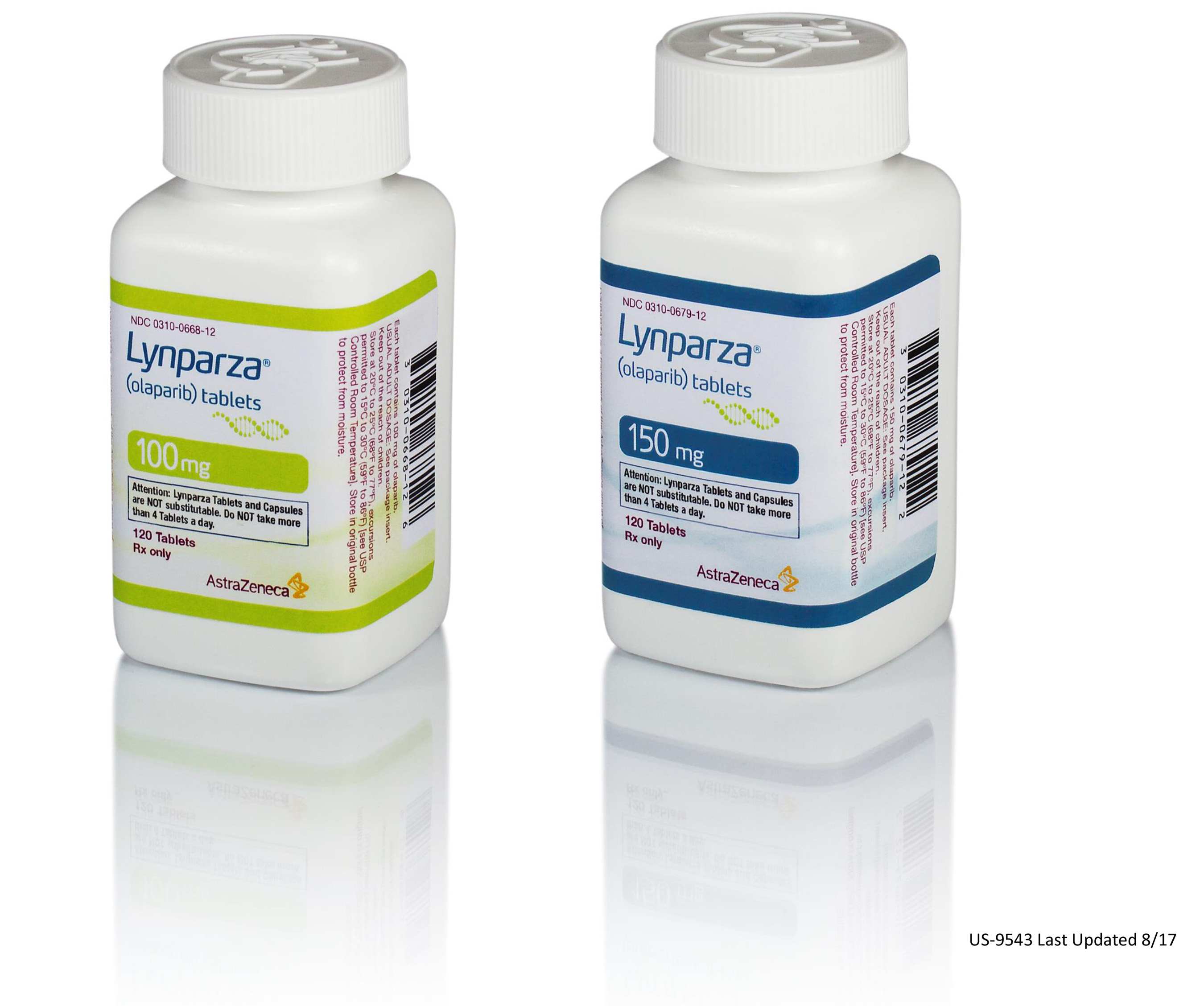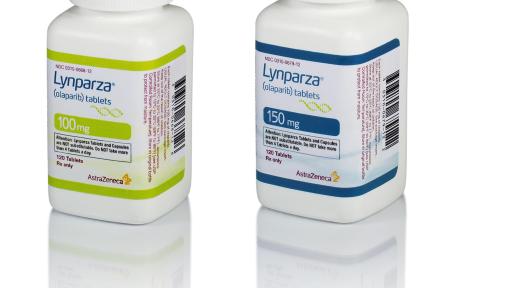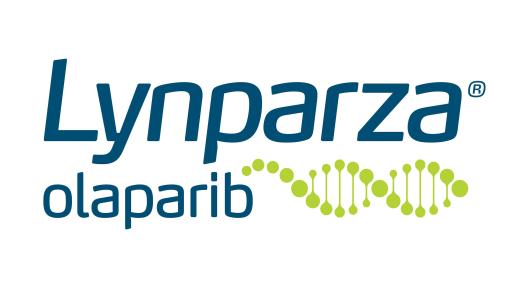LYNPARZA® (olaparib) RECEIVES ADDITIONAL FDA APPROVAL IN THE US FOR OVARIAN CANCER
LYNPARZA’s new tablet formulation approved as maintenance treatment for women with recurrent ovarian cancer regardless of BRCA-mutation status
LYNPARZA tablets also indicated in BRCA-mutated ovarian cancer beyond the third-line setting
Newly-approved tablet formulation means reduced pill count compared to capsules
(WILMINGTON, Del., August 17, 2017) – AstraZeneca and Merck & Co., Inc., (Merck: known as MSD outside the U.S. and Canada) today announced that the US Food and Drug Administration (FDA) has granted approval for the PARP inhibitor, LYNPARZA® (olaparib), as follows:
- New use of LYNPARZA tablets as a maintenance treatment of adult patients with recurrent, epithelial ovarian, fallopian tube or primary peritoneal cancer who are in a complete or partial response to platinum-based chemotherapy, regardless of BRCA status;1,2
- New use of LYNPARZA tablets (2 tablets twice daily) as opposed to capsules (8 capsules twice daily);3
- LYNPARZA tablets also now indicated (conversion from the current accelerated approval4) for the use in adult patients with deleterious or suspected deleterious germline BRCA-mutated (gBRCA) advanced ovarian cancer, who have been treated with three or more prior lines of chemotherapy; patients for this indication are selected for therapy based on an FDA-approved companion diagnostic.1
Sean Bohen, Executive Vice President, Global Medicines Development and Chief Medical Officer, AstraZeneca said: “Physicians have almost three years of clinical experience with LYNPARZA on the market and we are now pleased to bring this important medicine, in a new tablet formulation, to a broader group of women. Today’s approvals validate more than 10 years of dedicated research behind LYNPARZA, the world’s first PARP inhibitor, which now provides oncologists with the greater flexibility for use in terms of treatment settings. It builds on our recently-announced collaboration with Merck, which aims to further increase the number of treatment options available to patients.”
Richard Penson, MD, Clinical Director of Medical Gynecologic Oncology at Massachusetts General Hospital Cancer Center, Associate Professor of Medicine at Harvard Medical School, and the primary investigator in the SOLO-2 trial, said: “Today’s approval demonstrates that olaparib is an effective option for maintenance therapy for certain ovarian cancer patients, regardless of BRCA status. We welcome this news in the ovarian cancer community as more options are important to help us ensure that patients can find a treatment that is right for them.”
Roger M. Perlmutter, President of Merck Research Laboratories, said: “We congratulate AstraZeneca on the approval of these new indications and the new dosage form andschedule for LYNPARZA, an important therapeutic advance for many patients with ovarian cancer. This is a significant first regulatory event in our collaboration with AstraZeneca. We look forward to working with AstraZeneca in our global collaboration to bring this medicine with its new indications to patients.”
Two randomized trials supported the new approvals and the conversion of accelerated approval to full approval, which was originally based on a single-arm trial:1,3,4
- SOLO-2 (n=295) confirmed the benefit of LYNPARZA in gBRCA-mutated patients, demonstrating a 70% reduced risk of disease progression or death (HR 0.30 [95% CI, 0.22-0.41], P<0.0001) and improved median progression-free survival (PFS) to 19.1 vs 5.5 months for placebo by investigator-assessed analysis.1
- Study 19 (n=265) showed that LYNPARZA reduced the risk of disease progression or death by 65% and improved PFS compared with placebo in patients of any BRCA status (HR 0.35 [95% CI, 0.25-0.49], P<0.0001; median PFS of 8.4 months with LYNPARZA vs 4.8 months with placebo).1 Additionally, patients in Study 19, treated with LYNPARZA as a maintenance therapy, had a median overall survival (OS) of 29.8 months vs 27.8 months for placebo (HR 0.73 [95% CI, 0.55-0.95]).1
Table 1. Summary of key efficacy results from randomized trials:1
| Analysis | Reduction in the risk of disease progression or death (PFS) | Reduction in the risk of death (OS) | |
| SOLO-2 [gBRCAm] | LYNPARZA | 70% (HR 0.30 [95% CI, 0.22-0.41], P<0.0001) | Data not yet mature |
| Placebo | |||
| Study 19 [PSR OC*]2 | LYNPARZA | 65% (HR 0.35 [95% CI, 0.25-0.49], P<0.0001) | 27% (HR 0.73 [95% CI, 0.55-0.95] |
| Placebo | |||
*PSR = Platinum-sensitive recurrent ovarian cancer
The most common adverse reactions (≥20%) in clinical trials were anemia, nausea, fatigue (including asthenia), vomiting, nasopharyngitis/upper respiratory tract infection/influenza, diarrhea, arthralgia/myalgia, dysgeusia, headache, dyspepsia, and decreased appetite, constipation. and stomatitis. Most common laboratory abnormalities (≥25%) were decrease in hemoglobin, increase in mean corpuscular volume, decrease in lymphocytes, decrease in leukocytes, decrease in absolute neutrophil count, increase in serum creatinine and decrease in platelets.1
The full data from the SOLO-2 trial can be found in the July 25, 2017 publication of The Lancet Oncology.5
LYNPARZA was first approved under the FDA’s Accelerated Approval program in December 2014, as a capsule formulation, making it the first poly ADP-ribose polymerase (PARP) inhibitor approved.3,6 Since then, more than 3,000 advanced ovarian cancer patients have been treated with LYNPARZA capsules.7 LYNPARZA capsules are not indicated for maintenance therapy.1
IMPORTANT SAFETY INFORMATION
DOSING AND ADMINISTRATION
To avoid substitution errors and overdose, do not substitute LYNPARZA tablets with LYNPARZA capsules on a milligram-to-milligram basis due to differences in the dosing and bioavailability of each formulation. Recommended tablet dose is 300 mg, taken orally twice daily, with or without food. Continue treatment until disease progression or unacceptable toxicity. For adverse reactions, consider dose interruption or dose reduction.
WARNINGS AND PRECAUTIONS
There are no contraindications for LYNPARZA.
Myelodysplastic Syndrome/Acute Myeloid Leukemia (MDS/AML): Occurred in <1.5% of patients exposed to LYNPARZA monotherapy, and the majority of events had a fatal outcome. The duration of therapy in patients who developed secondary MDS/AML varied from <6 months to >2 years. All of these patients had previous chemotherapy with platinum agents and/or other DNA-damaging agents, including radiotherapy, and some of these patients also had a history of previous cancer or bone marrow dysplasia.
Do not start LYNPARZA until patients have recovered from hematological toxicity caused by previous chemotherapy (≤Grade 1). Monitor complete blood counts for cytopenia at baseline and monthly thereafter for clinically significant changes during treatment. For prolonged hematological toxicities, interrupt LYNPARZA and monitor blood counts weekly until recovery. If the levels have not recovered to Grade 1 or less after 4 weeks, refer the patient to a hematologist for further investigations, including bone marrow analysis and blood sample for cytogenetics. Discontinue LYNPARZA if MDS/AML is confirmed.
Pneumonitis: Occurred in <1% of patients exposed to LYNPARZA, and some cases were fatal. If patients present with new or worsening respiratory symptoms such as dyspnea, cough, and fever, or a radiological abnormality occurs, interrupt treatment with LYNPARZA and initiate prompt investigation. Discontinue LYNPARZA if pneumonitis is confirmed and treat patient appropriately.
Embryo-Fetal Toxicity: Based on its mechanism of action and findings in animals, LYNPARZA can cause fetal harm. A pregnancy test is recommended for females of reproductive potential prior to initiating treatment. Advise females of reproductive potential of the potential risk to a fetus and to use effective contraception during treatment and for 6 months after receiving the final dose.
ADVERSE REACTIONS—Maintenance Setting
Most common adverse reactions (Grades 1-4) in ≥20% of patients in clinical trials of LYNPARZA in the maintenance setting for SOLO-2: nausea (76%), fatigue (including asthenia) (66%), anemia (44%), vomiting (37%), nasopharyngitis/upper respiratory tract infection (URI)/influenza (36%), diarrhea (33%), arthralgia/myalgia (30%), dysgeusia (27%), headache (26%), decreased appetite (22%), and stomatitis (20%).
Study 19: nausea (71%), fatigue (including asthenia) (63%), vomiting (35%), diarrhea (28%), anemia (23%), respiratory tract infection (22%), constipation (22%), headache (21%), and decreased appetite (21%).
Most common laboratory abnormalities (Grades 1-4) in ≥25% of patients in clinical trials of LYNPARZA in the maintenance setting (SOLO-2/Study 19) were: increase in mean corpuscular volume (89%/82%), decrease in hemoglobin (83%/82%), decrease in leukocytes (69%/58%), decrease in lymphocytes (67%/52%), decrease in absolute neutrophil count (51%/47%), increase in serum creatinine (44%/45%), and decrease in platelets (42%/36%).
ADVERSE REACTIONS—Advanced gBRCAm ovarian cancer
Most common adverse reactions (Grades 1-4) in ≥20% of patients in clinical trials of LYNPARZA for advanced gBRCAm ovarian cancer after 3 or more lines of chemotherapy (pooled from 6 studies) were: fatigue (including asthenia) (66%), nausea (64%), vomiting (43%), anemia (34%), diarrhea (31%), nasopharyngitis/upper respiratory tract infection (URI) (26%), dyspepsia (25%), myalgia (22%), decreased appetite (22%), and arthralgia/musculoskeletal pain (21%).
Most common laboratory abnormalities (Grades 1-4) in ≥25% of patients in clinical trials of LYNPARZA for advanced gBRCAm ovarian cancer after 3 or more lines of chemotherapy (pooled from 6 studies) were: decrease in hemoglobin (90%), increase in mean corpuscular volume (57%), decrease in lymphocytes (56%), increase in serum creatinine (30%), decrease in platelets (30%), and decrease in absolute neutrophil count (25%).
DRUG INTERACTIONS
Anticancer Agents: Clinical studies of LYNPARZA in combination with other myelosuppressive anticancer agents, including DNA-damaging agents, indicate a potentiation and prolongation of myelosuppressive toxicity.
CYP3A Inhibitors: Avoid concomitant use of strong or moderate CYP3A inhibitors. If a strong or moderate CYP3A inhibitor must be co-administered, reduce the dose of LYNPARZA. Advise patients to avoid grapefruit, grapefruit juice, Seville oranges, and Seville orange juice during LYNPARZA treatment.
CYP3A Inducers: Avoid concomitant use of strong or moderate CYP3A inducers when using LYNPARZA. If a moderate inducer cannot be avoided, be aware of a potential for decreased efficacy of LYNPARZA.
USE IN SPECIFIC POPULATIONS
Pediatric Use: The safety and efficacy of LYNPARZA have not been established in pediatric patients.
Lactation: No data are available regarding the presence of olaparib in human milk, the effects on the breastfed infant, or the effects on milk production. Because of the potential for serious adverse reactions in the breastfed infant, advise a lactating woman not to breastfeed during treatment with LYNPARZA and for 1 month after receiving the final dose.
Hepatic Impairment: No adjustment to the starting dose is required in patients with mild hepatic impairment (Child-Pugh classification A). There are no data in patients with moderate or severe hepatic impairment.
Renal Impairment: No adjustment to the starting dose is necessary in patients with mild renal impairment (CLcr 51-80 mL/min). In patients with moderate renal impairment (CLcr 31-50 mL/min), reduce the dose to 200 mg twice daily. There are no data in patients with severe renal impairment or end-stage renal disease (CLcr ≤30 mL/min).
Please see complete Prescribing Information, including Patient Information (Medication Guide).
– ENDS –
NOTES TO EDITORS
About SOLO-2
SOLO-2 was a Phase III, randomized, double-blind, multicenter trial designed to determine the efficacy of LYNPARZA tablets as a maintenance monotherapy compared with placebo, in patients with platinum-sensitive, relapsed or recurrent gBRCA-mutated ovarian, fallopian tube and primary peritoneal cancer.8 The trial, conducted in collaboration with the European Network for Gynaecological Oncological Trial Groups (ENGOT) and Groupe d’Investigateurs National pour l’Etude des Cancers de l’Ovaire et du sein (GINECO), randomized 295 patients with documented germline BRCA1 or BRCA2 mutations who had received at least two prior lines of platinum-based chemotherapy and were in complete or partial response.5,8 Eligible patients were randomized to receive either LYNPARZA tablets (300mg twice daily) or placebo twice daily.5
About Study 19
Study 19 was a Phase II, randomized, double-blind, placebo-controlled, multicenter trial, which evaluated the efficacy and safety of LYNPARZA capsules compared with placebo in relapsed, high-grade serous ovarian cancer patients, involving 82 sites across 16 countries. Patients received olaparib maintenance monotherapy, at a dose of 400mg per day or matching placebo. Treatment continued until disease progression provided that toxicities were manageable.2
About LYNPARZA® (olaparib)
LYNPARZA was the first FDA-approved oral poly ADP-ribose polymerase (PARP) inhibitor that may exploit tumor DNA damage response (DDR) pathway deficiencies to potentially kill cancer cells.6,9,10 Specifically, in vitro studies have shown that olaparib-induced cytotoxicity may involve inhibition of PARP enzymatic activity and increased formation of PARP-DNA complexes, resulting in DNA damage and cancer cell death.1
LYNPARZA is the foundation of AstraZeneca’s industry-leading portfolio of compounds targeting DDR mechanisms in cancer cells.6,9,10
LYNPARZA tablets are currently being investigated in combinations in a range of tumor types, including breast, prostate, and pancreatic cancer.11-14
LYNPARZA capsules (400mg twice daily) will still be available through a limited specialty pharmacy network, for patients currently being treated for deleterious or suspected deleterious germline BRCA-mutated advanced ovarian cancer who have been treated with three or more prior lines of chemotherapy. LYNPARZA tablets and capsules are not the same.1
If you have been prescribed LYNPARZA tablets, do not take the capsules. If you have any questions about LYNPARZA, please talk with your physician or pharmacist.1
About the AstraZeneca and Merck Strategic Oncology Collaboration
On July 27, 2017, AstraZeneca and Merck & Co., Inc., announced a global strategic oncology collaboration to co-develop and co-commercialize AstraZeneca’s LYNPARZA, the world’s first and leading PARP inhibitor, and potential new medicine selumetinib, a MEK inhibitor, for multiple cancer types. The collaboration is based on increasing evidence that PARP and MEK inhibitors can be combined with PDL-1/PD-1 inhibitors for a range of tumor types and is aimed at maximizing the potential of LYNPARZA to become the preferred backbone of combination therapies. Working together, the companies will jointly develop LYNPARZA and selumetinib in combination with other potential new medicines and as a monotherapy. Independently, the companies will develop LYNPARZA and selumetinib in combination with their respective PD-L1 and PD-1 medicines.
About AstraZeneca in Ovarian Cancer
Approximately 20,000 women in the United States are diagnosed with ovarian cancer each year. Among women in the United States, it is the ninth most common cancer and the fifth leading cause of cancer death.15
The risk of developing ovarian cancer is increased in women with specific inherited genetic abnormalities, including BRCA mutations.16
AstraZeneca is committed to the continued development of our R&D portfolio for ovarian cancer, with a focus on improved care for all patients.
About AstraZeneca in Oncology
AstraZeneca has a deep-rooted heritage in Oncology and offers a quickly growing portfolio of new medicines that has the potential to transform patients’ lives and the Company’s future. With at least six new medicines to be launched between 2014 and 2020 and a broad pipeline of small molecules and biologics in development, we are committed to advance New Oncology as one of AstraZeneca’s five Growth Platforms focused on lung, ovarian, breast and blood cancers. In addition to our core capabilities, we actively pursue innovative partnerships and investments that accelerate the delivery of our strategy as illustrated by our investment in Acerta Pharma in hematology.
By harnessing the power of four scientific platforms – Immuno-Oncology, Tumor Drivers and Resistance, DNA Damage Response and Antibody Drug Conjugates – and by championing the development of personalized combinations, AstraZeneca has the vision to redefine cancer treatment and one day eliminate cancer as a cause of death.
About AstraZeneca
AstraZeneca is a global, science-led biopharmaceutical company that focuses on the discovery, development and commercialization of prescription medicines, primarily for the treatment of diseases in three main therapy areas – Oncology, Cardiovascular & Metabolic Diseases and Respiratory. The Company also is selectively active in the areas of autoimmunity, neuroscience and infection. AstraZeneca operates in over 100 countries and its innovative medicines are used by millions of patients worldwide. For more information, please visit www.astrazeneca-us.com and follow us on Twitter @AstraZenecaUS.
Media Inquiries
Michele Meixell +1 302 885 2677
Alexandra Engel +1 302 885 2677
References
- LYNPARZA (olaparib) Tablets Prescribing Information. AstraZeneca Pharmaceuticals LP, Wilmington, DE.
- Ledermann J, Harter P, Gourley M, et al. Olaparib maintenance therapy in platinum-sensitive relapsed ovarian cancer. N Engl J Med 2012;366:1382-1392.
- LYNPARZA (olaparib) Capsules Prescribing Information. AstraZeneca Pharmaceuticals LP, Wilmington, DE.
- AstraZeneca Press Release. LYNPARZA™ approved by the US Food and Drug Administration for the treatment of advanced ovarian cancer in patients with germline BRCA-mutations. Available Online. Accessed August 2017.
- Pujade-Lauraine E., Ledermann J., Selle F., et al. SOLO2/ENGOT-Ov21: A phase 3, randomised, double-blind, placebo-controlled trial of olaparib tablets as maintenance therapy in patients with platinum-sensitive, relapsed ovarian cancer and a BRCA1/2 mutation. Lancet Oncol 2017. Published online. http://dx.doi.org/10.1016/ S1470-2045(17)30469-2.
- US Food and Drug Administration. FDA approves Lynparza to treat advanced ovarian cancer. Accessed August 2017.
- Data on File, US-11033, AstraZeneca Pharmaceuticals LP.
- National Institutes of Health. Olaparib treatment in BRCA mutated ovarian cancer patients after complete or partial response to platinum chemotherapy. Available Online. Accessed August 2017.
- O’Connor M. Targeting the DNA damage response in cancer. Mol Cell. 2015; Accessed August 2017.
- Tutt AN, Lord CJ, McCabe N. Exploiting the DNA repair defect in BRCA mutant cells in the design of new therapeutic strategies for cancer. Cold Spring Harb Symp Quant Bio l. 2005;70:139-148.
- National Institutes of Health. Olaparib as adjuvant treatment in patients with germline BRCA mutated high risk HER2 negative primary breast cancer (OlympiA). Available Online. Accessed August 2017.
- National Institutes of Health. Assessment of the efficacy and safety of olaparib monotherapy versus physicians choice chemotherapy in the treatment of metastatic breast cancer patients with germline BRCA1/2 mutations (OlympiAD). Available Online. Accessed August 2017.
- National Institutes of Health. Olaparib in gBRCA mutated pancreatic cancer whose disease has not progressed on first line platinum-based chemotherapy (POLO). Available Online. Accessed August 2017.
- National Institutes of Health. Ph II study to evaluate olaparib with abiraterone in treating metastatic castration resistant prostate cancer. Available Online. Accessed August 2017.
- Centers for Disease Control and Prevention. Ovarian Cancer Statistics. Available Online. Accessed August 2017.
- National Cancer Institute. BRCA1 and BRCA2: cancer risk and genetic testing. Available Online. Accessed August 2017.
Related Links
Please See Full Prescribing Information www.Lynparza.com www.astrazeneca-us.comRelated Document
LYNPARZA fact sheet Ovarian Cancer Fact SheetUS-9541 Last Updated 8/17





